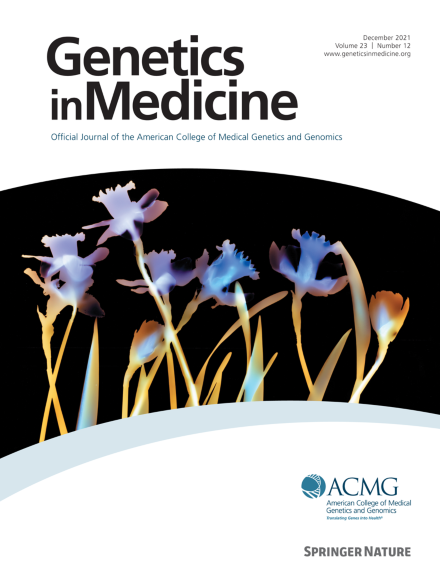A literature review and pooled case analysis of cardiofaciocutaneous syndrome to estimate cancer risk
IF 6.6
1区 医学
Q1 GENETICS & HEREDITY
引用次数: 0
Abstract
Purpose
We quantified cancer risk in cardiofaciocutaneous syndrome (CFC), a rare RASopathy.
Methods
From a comprehensive search, we reviewed articles from 5 databases and abstracted CFC cases with a clinical and/or molecular diagnosis to form a retrospective cohort. We collected information on BRAF, KRAS, MAP2K1, and MAP2K2 genetic variants when available. Genotype-phenotype (cancer) correlations, standardized incidence ratios (SIRs) with age stratification, cumulative incidence and cause-specific hazard rates for cancer and cancer-free in CFC were calculated. A sensitivity analysis with molecular diagnoses only was also performed.
Results
This study included 198 publications reporting 690 individuals. Only 1.6% (11) had cancer, including acute lymphoblastic leukemia. Six individuals had cancer and harbored pathogenic variants within BRAF, MAP2K1, and MAP2K2. Cumulative incidence by age 10 was 5% for cancer or cancer-free death. Hazard Ratio (death) was 1% to 2% until age 3 and declined thereafter. Significant SIRs were found for all sites (SIR = 4.96) and acute lymphoblastic leukemia (SIR = 24.23).
Conclusion
To our knowledge, this is the largest investigation of cancer in CFC to date. Cancer risk in the CFC population was elevated but appears to be limited to younger than age 3. However, modest case and cancer numbers limit accurate assessments of cancer risk in CFC and more studies are needed.
心皮肤综合征评估癌症风险的文献回顾和病例汇总分析。
目的:我们量化心-面部-皮肤综合征(CFC)的癌症风险,这是一种罕见的RASopathy。方法:通过全面检索,我们回顾了来自五个数据库的文章,并提取了临床和/或分子诊断的CFC病例,形成回顾性队列。我们收集了BRAF、KRAS、MAP2K1和MAP2K2基因变异的信息。计算了基因型-表型(癌症)相关性、标准化发病率(SIR)与年龄分层、CFC中癌症和无癌症的累积发病率和病因特异性危险率。仅进行分子诊断的敏感性分析。结果:本研究包括198篇出版物,报告690名个体。只有1.6%(11)患有癌症,包括急性淋巴细胞白血病(ALL)。6人患有癌症,并在BRAF、MAP2K1和MAP2K2中携带致病变异。10岁前癌症或无癌症死亡的累积发生率为5%。风险比(死亡)在3岁前为1-2%,此后下降。所有位点(SIR=4.96)和所有位点(SIR=24.23)的SIR均显著。结论:这是迄今为止在CFC中最大的癌症调查。氟氯化碳人群的癌症风险升高,但似乎仅限于三岁以下的儿童。然而,适度的病例和癌症数字限制了对氟氯化碳致癌风险的准确评估,需要更多的研究。
本文章由计算机程序翻译,如有差异,请以英文原文为准。
求助全文
约1分钟内获得全文
求助全文
来源期刊

Genetics in Medicine
医学-遗传学
CiteScore
15.20
自引率
6.80%
发文量
857
审稿时长
1.3 weeks
期刊介绍:
Genetics in Medicine (GIM) is the official journal of the American College of Medical Genetics and Genomics. The journal''s mission is to enhance the knowledge, understanding, and practice of medical genetics and genomics through publications in clinical and laboratory genetics and genomics, including ethical, legal, and social issues as well as public health.
GIM encourages research that combats racism, includes diverse populations and is written by authors from diverse and underrepresented backgrounds.
 求助内容:
求助内容: 应助结果提醒方式:
应助结果提醒方式:


